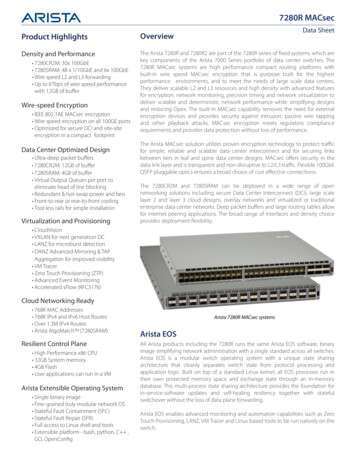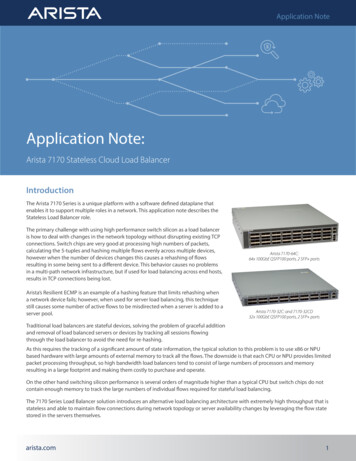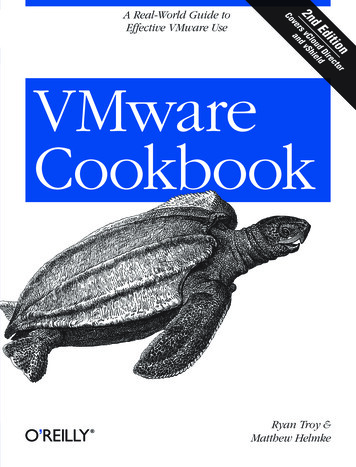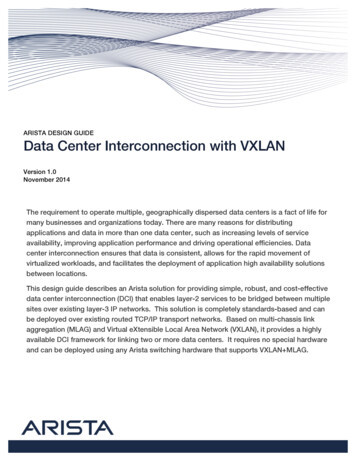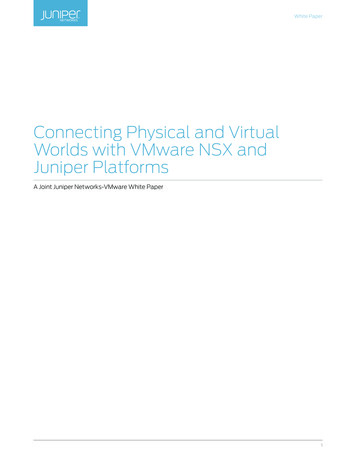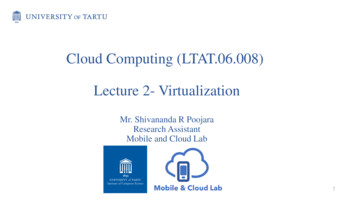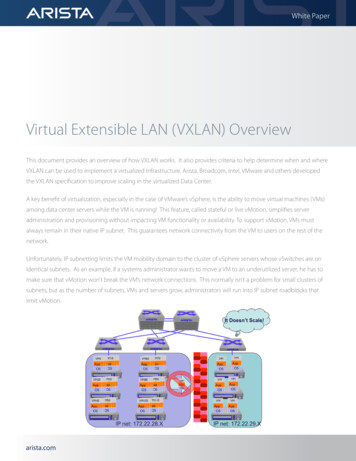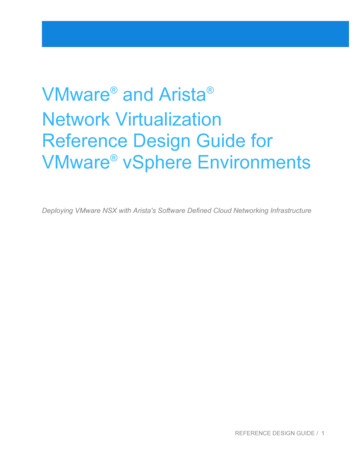
Transcription
VMware and Arista Network VirtualizationReference Design Guide forVMware vSphere EnvironmentsDeploying VMware NSX with Arista's Software Defined Cloud Networking InfrastructureREFERENCE DESIGN GUIDE / 1
TableofContentsExecutive Summary . 3Enabling the Software Defined Data Center . 3Combined solution using Arista EOS and VMware NSX . 4Arista EOS Extensibility . 5EOS: the Network Operating System designed to support Cloud Networking . 5VMware's NSX Network Virtualization Platform . 7Components of the NSX Platform . 7Why Deploy VMware NSX with Arista Network's Infrastructure . 9Physical Network Design Considerations . 11Physical Network Design Choices . 11Deploying Layer-3 Leaf-Spine Designs . 14Layer-2 MLAG Designs . 19Arista EOS Technologies used in the Designs . 20VMware NSX Network Design Considerations . 22Designing for Scale and Future Growth . 22Compute Racks . 23Edge Racks . 25Infrastructure Racks. 27Multi-tier Edges and Multi-tier Application Design Considerations . 29Logical Switching . 29Components . 30Transport Zone . 31Logical Switch Replication Modes . 31Logical Switch Addressing . 35With Network Address Translation . 35Without Network Address Translation . 37Logical Routing . 37Distributed Routing . 37Centralized Routing . 38Routing Components . 38Logical Switching and Routing Deployments . 40Physical Router as Next Hop . 40Edge Services Router as Next Hop . 40Scalable Topology . 41Logical Firewalling . 42Network Isolation . 42Network Segmentation . 43Taking Advantage of Abstraction . 43Advanced Security Service Insertion, Chaining and Steering . 43Logical Load Balancing . 44Integrating Visibility and Management with NSX and Arista. 46Conclusions . 48References . 49REFERENCE DESIGN GUIDE / 2
ExecutiveSummaryDisruptive changes in server and network virtualization are revolutionizing modern data center capabilities,enabling greater flexibility in provisioning of workloads, higher efficiencies in use and placement of resources,and breakthroughs in mobility and portability of applications and services. Entire data center environmentscan now be defined in software and replicated as required to support specific tenants and workloads - aconcept described here as the Software Defined Data Center (SDDC).Where new applications and services place different and often dynamic demands on the compute, networkand storage platforms contention can occur - leading to inefficient or unreliable services and poor end-userexperience. Enhanced visibility can enable proactive responses to these conditions, and customizableautomation of the underlay transport and overlay network can be used to ensure these new and complextopologies work efficiently and reliably. In the hyper-dynamic environment of the modern data center, theunderlay transport network and the overlay network virtualization solutions are co-dependent actors in thedelivery of optimal performance, reliability and scale.To best utilize the new capabilities of a Software Defined Data Center while providing maximum transparencyand performance, the underlying physical network must scale linearly and programmatically interface in aseamless manner with new network virtualization capabilities with very little contention and minimalend-to-end latency.This white paper presents a design approach for implementing VMware's NSX network virtualization platformwith Arista's Software Defined Cloud Networking (SDCN) infrastructure for optimal efficiency, reliability, scaleand migration. The combined solution of Arista networking platforms with Arista's Extensible OperatingSystem (EOS) and VMware NSX network virtualization platform provides a seamless path to an advancedSDDC.Intended Audience for this Paper This document is intended for virtualization and network architects interested in deploying VMware NSX network virtualization solutions for vSphere with Arista Networks' data center e pioneered the Software Defined Data Center (SDDC) to transform data center economics, increasebusiness agility and enable IT to become more efficient, and strategic to the organizations they serve. SDDCis defined by three pillars, virtualized compute, virtualized storage and virtualized network. Server and storagevirtualization have already delivered tangible benefits including reduced operational complexity, fastprovisioning of applications and dynamic repurposing of underlying resources, but the network has not keptpace until the arrival of network virtualization.Network virtualization is the ability to separate, abstract and decouple the physical topology of networks froma ‘logical’ or ‘virtual’ topology by using encapsulated tunneling. This logical network topology is often referredto as an ‘Overlay Network’. VMware NSX provides network virtualization, the third critical pillar of the SDDC.Similar to server virtualization, NSX network virtualization programmatically creates, snapshots, deletes, andrestores software-based virtual networks. This transformative approach to networking delivers greater agilityand economics while allowing for a vastly simplified operational model in the underlying physical network.NSX is a non-disruptive solution and can be deployed on any IP network, from existing traditional networkingmodels to next generation fabric architectures. No physical network infrastructure changes are required toimmediately get started with the Software Defined Data Center.SDDC enables new infrastructure design options that have the potential to improve and scale theperformance of applications. Figure 1 highlights the similarities between server and network virtualization.REFERENCE DESIGN GUIDE / 3
With server virtualization, a software abstraction layer (i.e., server hypervisor) reproduces attributes of an x86physical computer (e.g., CPU, RAM, disk, NIC) in software, allowing for programmatic assembly in anyarbitrary combination to produce a unique virtual machine (VM) in a matter of seconds.Figure 1. Server and Network Virtualization AnalogyWith network virtualization, the functional equivalent of a “network hypervisor” reproduces the complete set oflayer-2 to layer-7 networking services (e.g., switching, routing, access control, firewalling, QoS, loadbalancing, and visibility) in software. These services can be programmatically assembled to produce unique,isolated virtual networks.Similar benefits are seen in both compute and network virtualization. Virtual machines are independent of theunderlying x86 platform, allowing discrete physical hosts to be treated as a single pool of compute capacity.Virtual networks are independent of the underlying IP network, allowing the physical network to be treated asa single pool of transport capacity that can be consumed and repurposed on demand. Unlike legacyarchitectures, virtual networks can be provisioned, changed, stored, deleted and restored programmaticallywithout reconfiguring the underlying physical hardware or topology. By matching the capabilities and benefitsderived from familiar server and storage virtualization solutions, this flexible approach to networkingunleashes the full potential of the Software Defined Data Mware and Arista Networks are aligned in their vision for the role of network virtualization for realizing thefull potential of the Software Defined Data Center. VMware NSX works with any existing IP network, but theright coupling between NSX and the underlay network drives optimal data center benefits.The combined Arista and VMware solution is based on Arista’s data center class 10/40/100GbE networkingportfolio with Arista EOS and VMware NSX Virtual Networking and Security platform.At the core of the combined solution is the Arista Extensible Operating System (EOS) providing the industry’smost advanced network operating platform. EOS combines modern-day software and O/S architectures, anopen foundation for development with a standard Linux kernel, and a stateful publish/ subscribe in-memorydatabase model to provide a real-time programmatic, seamless and automated model for cloud networking.REFERENCE DESIGN GUIDE / 4
This paper will describe the use of VXLAN (Virtual extensible LAN) technology, an open multi-vendorstandard that has been developed and adopted by industry leaders in network, switching, firewalling,load-balancing, WAN optimization and application delivery. VXLAN provides a consistent, multi-vendorconnectivity model for implementing network virtualization.Together, Arista EOS and VMware NSX provide the essential integration and programmatic capabilities tooffer flexible workload placement and mobility for a true Software Defined Data Center.The VMware NSX and Arista EOS combined solution offers the following benefits to deploying networkvirtualization within data centers built on the foundation of Arista's Software Defined Cloud Networking: Virtual and physical workloads can be connected on a common logical segment on-demand regardless ofhypervisor, IP subnet or physical locationHolistic views of the virtual and physical topology increase operational efficiencyNetwork virtualization with NSX does not require IP multicast for learning or forwarding broadcast,unknown unicast or multicast packetsA single point of management and control via NSX APIs and EOS APIs to configure the logical networksacross hypervisors and the physical network fabric.Arista EOS ExtensibilityCore to successful implementation of Arista SDCN is the extensibility of Arista networking operating system.While the modularity, distributed scalability, and real-time database interaction capabilities of Arista EOS arementioned throughout this document, there are other aspects to consider as well. These considerationsinclude the ability to write scripts and load applications (such as third-party RPM Package Managers [RPMs])directly onto the network operating system, and to run these applications as guest VMs. Arista provides adeveloper’s site called “EOS Central” for customers that are interested in this hosting model.Leveraging the extensibility model of Arista EOS several applications have been developed that dramaticallyenhance the availability, integration and transparency of the combined VMware NSX and Arista EOS solution:Arista Smart System UpgradeArista Smart System Upgrade (SSU) is a series of patent-pending technologies that enable the networkoperator to seamlessly align one of the most challenging periods of network operations, the upgrade andchange management operation, with the networks operational behaviors. The network, with SSU, is capableof gracefully exiting the topology, moving workloads off of directly-connected hosts, and aging out server loadbalancer Virtual IPs (VIPs) before any outage is ever seen. The multi-step, multi-hour process many networkoperators go through to achieve maximum system uptime becomes the default method of operations. SSUhas demonstrated interoperability with F5 Load Balancers, VMware vSphere, OpenStack, and more.Arista Network TelemetryLastly, Network Telemetry is all about accessing machine and wire data: generating, collecting, anddistributing the telemetry data necessary to make well informed network decisions about where problems maybe happening, thus ensuring the data is available and easily reachable and indexed so these hot spots, orproblem areas, are rapidly fixed and troubleshooting is simple and quick. Network Telemetryprogrammatically interfaces with VMware vCenter Log Insight, Splunk, and several other log managementand rotation/indexing tools and provides a rich source of operational visibility.EOS: the Network Operating System designed to support Cloud NetworkingAn open modular network operating system with the ability to respond in real time to both internal andexternal control operations is required to support SDN, cloud and SDDC. Unfortunately, not all switchoperating systems offer this capability because many of them were architected a decade or more ago, beforeREFERENCE DESIGN GUIDE / 5
the need for hyper-dynamic cloud environments, and the interaction with external controllers was notenvisioned.These older operating systems typically interact internally through a proprietary message-passing protocolsand externally with non real-time state information (or APIs). Many configuration, forwarding, race, and stateproblems arise when multitasking occurs in real time with multiple dynamic systems, as in the case ofcommunicating with external controllers while trying to resolve topology changes. The message-passingarchitectures of these legacy switches prevent these operating systems from quickly and reliably multitaskingwith external controllers in dynamic cloud environments.A modular network operating system designed with a real-time interaction database, and with API-levelintegration both internally and externally, is a better approach. The system can, therefore, integrate and scalemore reliably. In order to build a scalable platform, a database that is used to read and write the state of thesystem is required. All processes, including bindings through APIs, can then transact through the database inreal time, using a publish and subscribe message bus. Multiple systems, both internally and externally, cansubscribe, listen, and publish to this message bus. A per-event notification scheme can allow the model toscale without causing any inter-process dependencies.Closed network operating systems that are built on older design principles can, at best, offer one-offimplementations and struggle to support the growing list of different SDN controller form factors. Arista, on theother hand, is in a unique leadership position—the industry award-winning modular Arista EOS softwareplatform can interact with multiple virtualization and cloud orchestration systems concurrently, handlingexternal controller updates and managing highly distributed switch forwarding states, both in real time. TheArista approach to Software Defined Cloud Networking offers the best of both worlds, providing servicecontrol to external controllers, while scaling with Leaf-Spine switching architectures for the most demandingenterprise and carrier-class software-defined cloud data centers.REFERENCE DESIGN GUIDE / 6
VMware'sNSXNetworkVirtualizationPlatformVMware NSX is a network virtualization platform that delivers the operational model of a virtual machine forthe network. Virtual networks reproduce the network model in software, allowing complex multi-tier networktopologies to be created and provisioned programmatically in seconds. NSX includes a library of logicalnetworking services – logical switches, logical routers, logical firewalls, logical load balancers, logical VPN,QoS, and distributed security.A self-service interface allows users to create custom combinations of these services in isolatedsoftware-based virtual networks that support existing applications without modification, or that can deliverunique requirements for new application workloads on-demand. Similar to virtual machines in compute, virtualnetworks are programmatically provisioned and managed independent of networking hardware. Decouplingfrom hardware introduces agility, speed and operational efficiency that has the power to transform data centereconomics.ComponentsoftheNSXPlatformFigure 2. VMware Network Virtualization Platform ComponentsConsumptionConsumption of NSX is enabled directly via the NSX manager through the Web UI. In a vSphere environmentthis is available through the vSphere Web UI. Network virtualization is typically tied to a Cloud ManagementPlatform (CMP) for application deployment. NSX provides a rich set of integration features to connect intovirtually any CMP via the REST API. Out-of-the-box integration is also available through VMware vCloudAutomation Center and vCloud Director.REFERENCE DESIGN GUIDE / 7
Management PlaneThe NSX manager builds the NSX management plane. The NSX manager provides the single point ofconfiguration and REST API entry points in a vSphere environment for NSX.Control PlaneThe NSX control plane exists solely within the NSX controller. In a vSphere-optimized environment with thevSphere Distributed Switch (VDS), the controller enables multicast-free VXLAN and control planeprogramming for elements such as Logical Distributed Routers (LDRs).The NSX controller is essentially contained within the control plane; no data plane traffic passes through it.Controller nodes are deployed in redundant and distributed clusters to enable high-availability and scale. Withthe NSX controller deployment model, any failure of a single controller node will not impact data plane traffic.The NSX Control VM component performs Dynamic Routing Control plane functions, peering with NSX EdgeGateways and communicating Routing Protocol updates to the NSX Controller Cluster.Data PlaneThe NSX data plane is managed by the NSX vSwitch. The vSwitch in NSX for vSphere is based on thestandard vSphere VDS with additional components that enable rich services. Add-on NSX componentsinclude kernel modules (VIBs) running within the hypervisor kernel, providing services that enable distributedrouting, distributed firewall, and VXLAN bridging capabilities.The NSX VDS vSwitch abstracts the physical network and provides access-level switching in the hypervisor.It is central to network virtualization, enabling logical networks that are independent of physical constructssuch as VLANs. Benefits of the VDS vSwitch include: Support for overlay networking, leveraging the VXLAN protocol and centralized network configurationincluding ü Creation of a flexible logical layer-2 overlay over existing IP networks on existing physicalinfrastructure without the need to re-architect any of the data center networksü Provisioning of communication (east-west and north-south) while maintaining isolation betweentenantsü Operation of application workloads and virtual machines that are agnostic of the overlay network, as ifthey were connected to a physical layer-2 networkSignificant hypervisor scalabilityMultiple visibility and management features - including port mirroring, NetFlow/IPFIX, configurationbackup and restore, network health check, QoS, and LACP – to provide a comprehensive toolkit for trafficmanagement, monitoring, and troubleshooting within a virtual network.The data plane also consists of network virtualization gateways, which provide layer-2 bridging from thelogical networking space (VXLAN) to the physical network (VLAN). The gateway device is typically an NSXEdge virtual appliance, which offers services including layer-2, layer-3, perimeter firewall, load balancing, SSLVPN, and DHCP.Functional Services of NSX for vSphereThis design guide details how the components described provide the following functional services: Logical Layer-2 Connectivity. Enabling extension of an layer-2 segment/IP subnet anywhere in thefabric irrespective of the physical network design.Distributed Layer-3 Routing. Routing between IP subnets can be done in a logical space without traffictouching the physical router. This routing is performed directly in the hypervisor kernel with minimalCPU/memory overhead. This functionality provides an optimal data path for routing traffic within theREFERENCE DESIGN GUIDE / 8
virtual infrastructure. Similarly, the NSX Edge provides a mechanism for fully dynamic route peering usingOSPF, BGP, or IS-IS with the physical network to enable seamless integration.Distributed Firewall. Security enforcement is done at the kernel and VNIC level, allowing firewall ruleenforcement to scale in an efficient manner without creating bottlenecks on physical appliances. Thefirewall is distributed in kernel, creating minimal CPU overhead and allowing line-rate performance.Logical Load-balancing. Support for layer-4 to layer-7 load balancing with the ability to do SSLtermination.VPN Services. SSL VPN services to enable layer-2 VPN astructureArista’s scale-out cloud network designs provide an ideal platform for deployment of NSX networkvirtualization, utilizing principles that have made both cloud computing and software-defined networkingcompelling. All Arista reference designs revolve around common central design goals.Simplified Standards-based Architecture: Arista is an established leader in data center networkarchitectures designed for consistent performance, deterministic latency, and easy troubleshooting regardlessof workload and deployment sizes. Arista's Multi-Chassis Link Aggregation (MLAG) and Equal Cost Multipath(ECMP) routing are standards-based approaches used for scalable cloud networking designs and take theplace of proprietary fabrics. These design fundamentals ensure effective use of all available networkbandwidth, provide non-blocking active-active forwarding and redundancy, and enable excellent failover andresiliency characteristics. For any SDDC, MLAG and ECMP cover all of the important multipath deploymentscenarios in a practical manner without introducing any complicated or proprietary lock-in.Massively Scalable: Reference designs are based on open standards for building out horizontally scalablenetworks from the smallest of pod sizes to hyper-scale designs. Universal cloud networks may be built onlayer-2 or layer-3 multi-pathing technologies (leveraging MLAG or ECMP routing) for a scalable,standards-based approach that does not compromise workload performance. Together these technologiescover all important multi-path deployment scenarios without introducing any proprietary protocols or designelements. Implementations in these reference designs can scale linearly from small enterprise deployments tolarge cloud provider networks.Open and Programmable: Arista’s EOS (Extensible Operating System), is a programmable networkoperating system based on a universal single image across all Arista products. Arista EOS providesextensibility at every level of the network. Central features include: a self-healing resilient in-memory statedatabase; true on-switch access to a standard Linux operating system, advanced Event Manager (AEM) totrigger custom automations; custom Python scripting and programming environment; and direct JSONapplication interfaces via EOS Application Programming Interface (eAPI).Consistent and Interoperable: All Arista switches use the same Arista EOS across the entire Arista productportfolio, allowing certification and tracking of a single software image for the entire network. Arista switchesand designs use standard open protocols including spanning tree, Link Aggregation Control Protocol (LACP),Open Shortest Path First (OSPF), and Border Gateway Protocol (BGP) for interoperability with othernetworking systems.Maximizing Throughput: Modern operating systems, network interface cards (NICs), and scale-out storagearrays make use of techniques such as TCP segmentation offload (TSO), generic segmentation offload(GSO) and large segment offload (LSO) to push more data onto the network. These techniques arefundamental to reducing CPU cycles on servers and storage arrays when sending large amounts of data. Aside effect of these techniques is that systems that need to transmit large blocks of data will offloadprocessing to it's NIC, which must slice the data into segments and put them on the wire as a burst ofback-to-back frames at line-rate.REFERENCE DESIGN GUIDE / 9
If more than one of these is destined to the same network destination, microburst congestion within thenetwork could occur causing significantly reduced end-to-end throughput. This can be exceedingly difficult totroubleshoot. Common approaches to dealing with the impact of microbursts include over-provisioning andreducing traffic fan-in by design. An alternative approach is to deploy Arista switches with deep buffers at theSpine-layer to absorb the bursts that could otherwise result in frequent packet loss and inefficiency. Arista'sdeep buffer architectures are better at handling a variety of traffic loads and dynamically managing per-portpacket memory allocation to avoid packet loss due to microbursts.Support for Integration with Existing Legacy InfrastructureIn reality not all resources will be virtualized in the SDDC. This may be due to specific performance orlatency-sensitive demands of specific applications, like databases or layer-4 to layer-7 services like loadbalancers or firewalls. In addition, during migration to the SDDC many existing storage and computeresources may need to be incorporated into the virtualization infrastructure. This is easily accomplishedwith Network virtualization gateways, mentioned earlier, which can provide VXLAN Tunnel Endpoint(VTEP) termination at a VLAN or physical port boundary. Gateways create an on-ramp for existingphysical infrastructure components to tie into the virtualized NSX overlay network.Either VMware's NSX Edge virtual appliance or Arista's EOS based switches can support networkvirtualization gateways based on software and/or hardware-based forwarding respectively. Increasingbandwidth demands that are driven as the SDDC implements more 10/40/100Gbps connectivity, will drivedemand for scalable gateways that can provide terabits-per-second of aggregate bandwidth across manynetwork segments. This is achie
VMware NSX works with any existing IP network ,but the right coupling between NSX and the underlay network drives optimal data center benefits. The combined Arista and VMware solution is based on Arista's data center class 10/40/100GbE networking portfolio with Arista EOS and VMware NSX Virtual Networking and Security platform.




